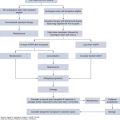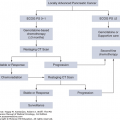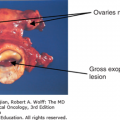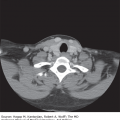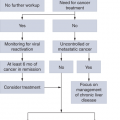INTRODUCTION
The Human Genome Project has enabled sequencing of human DNA and led to advancements in technologies that detect genomic, transcriptional, proteomic, and epigenetic changes. These technologies, combined with novel drug development, have accelerated the implementation of personalized medicine. Personalized medicine uses concepts of the genetic and environmental bases of disease to individualize prevention, diagnosis, and treatment (1,2). Optimization of treatment using targeted therapy—molecules targeting specific enzymes, growth factor receptors, and signal transducers, thereby interfering with a variety of oncogenic cellular processes—and other strategies made possible by advances in translational medicine holds the promise of improving patient care (3).
This chapter focuses on targeted therapy in cancer therapeutics. The material is organized according to the key drivers of carcinogenesis in humans and summarizes the current state-of-the-art applications of personalized medicine.
RAS-RAF-MEK PATHWAY
Upregulation of the mitogen-activated protein kinase (MAPK) cascades RAF (rapidly accelerated fibrosarcoma) and MEK (MAPK/extracellular signal-regulated kinase [ERK]) contributes to carcinogenesis. Several cell surface molecules activate RAS (KRAS, NRAS, and HRAS), a family of guanine triphosphatases (GTPases) that activate downstream RAF protein kinases (BRAF, CRAF, and ARAF). The most important substrates of RAF kinases are MEK1 and MEK2 (MAPK/ERK kinases). The MEK kinases have one main substrate, ERK (4). Activation of ERK leads to modifications in gene expression mediated by transcription factors that control cell cycle progression, differentiation, metabolism, survival, migration, and invasion. This pathway regulates apoptosis by the posttranslational phosphorylation of apoptotic regulatory molecules (Bad, Bim, Mcl-1, and caspase 9). RAS is a downstream effector of the epidermal growth factor receptor (EGFR). Activation of ERK promotes upregulated expression of EGFR ligands and an autocrine loop critical for tumor growth (5). The frequency of molecular alterations in major pathway components is shown in the COSMIC (Catalogue of Somatic Mutations in Cancer) database (http://www.sanger.ac.uk/genetics/CGP/cosmic/).
Mutations in BRAF are found in 62% to 72% of patients with metastatic melanoma (6) and are less frequent in the radial growth phase (10%) and in situ (5.6%) melanomas (7). Mutations of NRAS occur in 5.2% of melanomas (7). In conjunctival melanoma, BRAF and NRAS mutations were identified in 29% and 18% of patients, respectively (8). Alterations of KIT were found in 36% and 39% of patients with acral and mucosal melanoma, respectively (9). Alterations of GNAQ and GNA11 were found in 45% and 32% of patients with uveal melanoma, respectively (10).
Inhibitors of BRAF and MEK have been approved by the US Food and Drug Administration (FDA) based on their significant antitumor activity and tolerability in patients with melanoma. The FDA-approved drugs and selected investigational agents by molecular target/pathway are listed in Table 49-1.
| Pathway/Target | FDA-Approved Drugs | Investigational Agents |
|---|---|---|
| RAS-RAF-MEK pathway | ||
| BRAF | Dabrafenib (Tafinlar) | Encorafenib (LGX818) |
| Vemurafenib (Zelboraf) | GDC-0879 | |
| PLX-4720 | ||
| MEK | Trametinib (Mekinist) | Cobimetinib (GDC-0973) |
| Selumetinib (AZD6244) | ||
| RAS | Tipifarnib | |
| Lonafarnib | ||
| PI3K/AKT/mTOR pathway | ||
| mTOR | Everolimus (Afinitor) | MLN0128 |
| Temsirolimus (Torisel) | JNK128 | |
| AZD8055 | ||
| Ridaforolimus | ||
| PI3K | BKM120 | |
| Copanlisib (BAY 80-6946) | ||
| XL-147 | ||
| GDC-0032 (Taselisib) | ||
| INK1117 | ||
| BYL719 | ||
| GDC-0941 | ||
| PI3K and mTOR | BEZ235 | |
| XL-765 | ||
| BGT-226 | ||
| GDC-0980 | ||
| PF4691502 | ||
| AKT | MK2206 | |
| GSK2141795 | ||
| BAY1125976 | ||
| GDC-0068 | ||
| p70S6K/AKT | MSC2363318A | |
| BRCA | ||
| PARP | Olaparib (Lynparza) | ABT-888 (Veliparib) |
| PF-01367338 (Rucaparib) | ||
| BMN 673 (Talazoparib) | ||
| EGFR | Cetuximab (Erbitux) | CO-1686 (Rociletinib) |
| Erlotinib (Tarceva) | ||
| Afatinib (Gilotrif) | ||
| Panitumumab (Vectibix) | ||
| EGFR, RET, VEGFR2 | Vandetanib (Caprelsa) | |
| HER2 | Pertuzumab (Perjeta) | |
| Trastuzumab (Herceptin) | ||
| HER2 and EGFR | Lapatinib (Tykerb) | |
| ALK | Ceritinib (Zykadia) | Alectinib |
| Crizotinib (Xalkori) | AP26113 (Brigatinib) | |
| ASP3026 | ||
| PF-06463922 | ||
| X-396 | ||
| NOTCH | Tarextumab (OMP-59R5) | |
| OMP-21M18 (Demcizumab) | ||
| MK-0752 | ||
| RO4929097 | ||
| PF-03084014 | ||
| KIT, PDGFR, ABL | Imatinib (Gleevec) | Bosutinib (Bosulif) |
| Dasatinib (Sprycel) | ||
| Ponatinib (Iclusig) | ||
| KIT, PDGFRβ, RAF, RET, VEGFR1/2/3 | Regorafenib (Stivarga) | Dovitinib |
| Sorafenib (Nexavar) | ||
| VEGF ligand | Bevacizumab (Avastin) | |
| Receptor tyrosine kinase (RTK) inhibitor | Sunitinib (Sutent) | |
| VEGF | Nintedanib (Ofev) | Brivanib (BMS-540215) |
| MET | AMG102 (Rilotumumab) | |
| AV-299 (Ficlatuzumab) | ||
| MetMab (Onartuzumab) | ||
| LY-2875358 | ||
| h224G11A | ||
| DN30 | ||
| MGCD-265 | ||
| Tivantinib (ARQ197) | ||
| JNJ-38877605 | ||
| AMG 337 | ||
| AMG 208 | ||
| PF-04217903 | ||
| EMD-1214063 | ||
| LY-2801653 | ||
| INC-280 | ||
| Foretinib (GSK1363089) | ||
| Cabozantinib (Cometriq) | ||
| FGF | Brivanib | |
| Dovitinib (TKI258) | ||
| AZD4547 | ||
| BAY1187982 | ||
| Lucitanib | ||
| Ponatinib (Iclusig) | ||
| TAS-120 | ||
| Debio 1347 (CH5183284) | ||
| BAY1163877 | ||
| FGF401 | ||
| BGJ398 | ||
| Nintedanib (BIBF1120) | ||
| JNJ-42756493 | ||
| GSK3052230 | ||
| ARQ 087 | ||
| BAY1179470 | ||
| FPA144 | ||
| P53 MDM2 | DS-3032b | |
| RO6839921 | ||
| RO5045337 | ||
| RO5503781 | ||
| HDM201 |
Vemurafenib was the first BRAF FDA-approved inhibitor for metastatic melanoma with a BRAF V600E mutation. A phase III trial demonstrated a 3.7-month improvement in progression-free survival (PFS) in the vemurafenib arm compared to the dacarbazine arm (median PFS 5.3 months and 1.6 months, respectively). The median overall survival (OS) was not reached in the vemurafenib arm and was 7.9 months in the control arm (11). Dabrafenib is also FDA approved for patients with unresectable or metastatic melanoma with a BRAF V600E mutation, based on the results of a phase III study that compared dabrafenib with dacarbazine. The median PFS was 5.1 months and 2.7 months in the dabrafenib and the dacarbazine arms, respectively (12). Vemurafenib (13) and dabrafenib (14) have antitumor activity in patients with melanoma and brain metastases.
Trametinib is a MEK1/MEK2 kinase inhibitor that was approved by the FDA as a single agent or combined with dabrafenib for unresectable or metastatic melanoma with a BRAF V600E or V600K mutation. Approval was based on the results of a randomized trial, which demonstrated longer PFS with trametinib than with chemotherapy consisting of either dacarbazine or paclitaxel in patients with stage IIIc or IV melanoma and a BRAF V600E or V600K mutation (15). The median PFS durations were 4.8 and 1.5 months in the trametinib and chemotherapy arms, respectively (hazard ratio [HR], 0.47; P < .0001). The 6-month OS rates were 81% and 67%, respectively (15).
In a phase I and II study of dabrafenib plus trametinib or dabrafenib monotherapy in patients with melanoma and a BRAF V600E or V600K mutation, the objective response (complete response [CR] and partial response [PR]) rates were 76% and 54%, respectively (P = .03) (16). Cutaneous squamous cell carcinoma (SCC), an adverse event associated with BRAF inhibitors, was less common in the dabrafenib plus trametinib group than in the dabrafenib group (7% vs 19%, respectively) (16).
Other MEK inhibitors are in clinical trials. In a randomized phase II study in patients with BRAF-mutated advanced melanoma, selumetinib (MAP2K1/MAP2K2 inhibitor) plus dacarbazine was associated with longer PFS compared to dacarbazine (5.6 vs 3 months), but no improvement in OS was noted (17).
Mutations in BRAF occur in 1% to 4% of patients with non–small cell lung cancer (NSCLC). Molecular alterations in EGFR, ALK, ROS1, NRAS, and KRAS are also involved in the pathogenesis of lung cancer. We have noted responses in patients with NSCLC and BRAF V600E mutation treated with vemurafenib. A study of dabrafenib with or without trametinib in BRAF V600E–mutant NSCLC is ongoing.
Mutations of KRAS are more common in smokers. In metastatic NSCLC, mutated KRAS is associated with a worse prognosis than mutated EGFR. Mutation of KRAS was associated with shorter PFS in patients receiving maintenance erlotinib. No difference was noted in OS between mutated and wild-type KRAS (18). In colorectal cancer (CRC), KRAS mutations are associated with resistance to cetuximab. In a phase II study, selumetinib combined with docetaxel was associated with a higher response rate (37%, all PRs) in patients with KRAS-mutant NSCLC compared to docetaxel plus placebo (0%) (19). Other clinical trials evaluating MEK inhibitors combined with chemotherapy in KRAS-mutant NSCLC have been completed (NCT01192165, NCT01362296). In a phase II randomized study of trametinib compared to docetaxel in patients with KRAS-mutant NSCLC (20), the rates of response and PFS were similar in the two arms (response, 12% [all PR]; median PFS, trametinib: 12 weeks; docetaxel: 11 weeks). Other studies of RAS-RAF-MEK inhibitors are ongoing.
PI3K-AKT-mTOR PATHWAY
The phosphatidylinositol 3-kinase (PI3K) signaling pathway is involved in the survival, growth, metabolism, motility, and progression of cancer and is a critical pathway in cancer (21). The PI3K family of proteins catalyzes the phosphorylation of phosphatidylinositols (PtdIns) at their 3’ position and consists of classes I, II, and III. Only class IA signaling aberrations are involved in human cancers (22). The class IA PI3Ks are composed of heterodimers of regulatory subunits (p85α, p85β, p50α, p55α, and p55γ) and catalytic subunits (p110α, p110β, p110δ). Three genes encode the regulatory subunits: PIK3R1 encodes p85α (22), and PIK3R2 and PIK3R3 encode the p85β and p55γ isoforms of the p85 regulatory subunit, respectively. Three genes, PIK3CA, PIK3CB, and PIK3CD, encode the highly homologous p110 catalytic subunit isoforms p110α, p110β, and p110δ and share a similar five-domain structure. At the amino terminus, there is an adapter-binding domain that interacts with the p85 regulatory subunit, followed by a RAS-binding domain that mediates interaction with RAS.
The class I PI3Ks can phosphorylate the 3’ position of PtdIns, PI-4-P, and PI-4,5-P2 though PI-4,5-P2. This phosphorylation generates the second-messenger phosphatidylinositol (3,4,5) triphosphate (PIP3). Cytosolic proteins, such as the AKT family of protein-serine/threonine kinases, bind to PIP3 and localize to the plasma membrane in response to PI3K activation (23). In the absence of stimulated growth conditions, baseline levels of PIP3 are undetectable in mammals. The PIP3 levels at the plasma membrane are regulated by the tumor suppressor phosphatase and tensin (PTEN) homolog, whose lipid phosphatase activity converts PIP3 to PI-4,5-P2. Loss of PTEN function through inactivating mutations, deletion, chromosomal translocation, or epigenetic silencing is the second most common initiating event in cancer after p53 mutations.
Mutations or amplifications of the PI3K catalytic subunits p110α (PIK3CA) and p110β (PIK3CB), the PI3K regulatory subunits p85α (PIK3R1) and p85β (PIK3R2), and AKT (AKT1) can activate the PI3K pathway. Mutations, deletions, or epigenetic changes in negative regulators of the PI3K axis (PTEN and inositol polyphosphate-4-phosphatase, type II) may modify tumor cell sensitivity to chemotherapy or targeted therapies (24). AKT is the main effector of PI3K activation and has three isoforms: AKT1, AKT2, and AKT3. AKT signaling plays a significant role in cell hypertrophy, survival, hyperplasia, and metabolism. Mammalian target of rapamycin (mTOR) is the catalytic subunit of mTOR complex 1 (mTORC1) and mTOR complex 2 (mTORC2), which are distinguished by their accessory proteins, regulatory-associated protein of mTOR (RAPTOR) and rapamycin-insensitive companion of mTOR (RICTOR) (25).
Several studies focused on targeting the PI3K-AKT-mTOR pathway. Rapamycin analogues (rapalogs) have antitumor activity in various tumors and are frequently combined with other anticancer agents (26). Everolimus is approved for the treatment of subependymal giant cell astrocytoma; hormone receptor (HR)-positive, HER2 (human epidermal growth factor receptor 2)-negative breast cancer (in combination with exemestane); neuroendocrine pancreatic tumors; tuberous sclerosis–associated subependymal giant cell astrocytoma; and renal cell carcinoma (sunitinib or sorafenib refractory). Temsirolimus is approved for renal cell carcinoma. The efficacy of rapalogs combined with endocrine therapy for advanced breast cancer was evident in the BOLERO-2 trial, which showed a median PFS of 6.9 months for everolimus and exemestane versus 2.8 months for exemestane alone (27).
The first generation of class I pan-PI3K inhibitors targeted PI3Kα, PI3Kβ, PI3Kγ, and PI3Kδ. Wortmannin and LY294002 had limited activity. Ongoing studies are evaluating new pan-PI3K inhibitors with improved pharmacokinetic profiles and target specificity. Their antitumor activity is primarily cytostatic. Novel agents that inhibit both PI3K and mTOR may improve the antitumor activity of either agent.
GDC-0941 is a selective oral class I PI3K inhibitor and at high concentrations also an mTOR inhibitor. It is being investigated in clinical trials in patients with metastatic breast cancer (NCT00960960, NCT01437566) and advanced NSCLC. Initial studies of GDC-0941 demonstrated PRs in patients with melanoma and ovarian, cervical, and estrogen receptor (ER)–positive/HER-negative breast cancer (28,29,30). At the maximum tolerated dose (MTD), dose-limiting toxicities (DLTs) included grade 3 macular rash and asymptomatic T-wave inversion on electrocardiograms, grade 3 thrombocytopenia, and grade 4 hyperglycemia (29,30). Ongoing studies evaluating GDC-0941 include a phase II study in patients with untreated advanced or recurrent NSCLC treated with carboplatin/paclitaxel or carboplatin/paclitaxel/bevacizumab with or without GDC-0941 (NCT01493843). In a phase I/II study, GDC-0941 and cisplatin are being studied in patients with androgen receptor (AR)–negative, triple-negative, metastatic breast cancer, and in a phase II study, patients with advanced/metastatic breast cancer resistant to aromatase inhibitor therapy are being treated with GDC-0941 or GDC-0980 with fulvestrant versus fulvestrant alone (NCT01437566). Clinical trials are also investigating combinations of PI3K inhibitors taselisib (GDC-0032) or pictilisib (GDC-0941) with other targeted agents (eg, palbociclib, a cyclin-dependent kinase 4 and 6 [CDK4/6] inhibitor) in advanced solid tumors or breast cancer (NCT02389842).
BKM120 is an oral pyrimidine-derived pan-PI3K inhibitor with activity against all class I PI3K isoforms. A phase I study demonstrated that BKM120 was well tolerated, with a dose-dependent safety profile (31). Adverse events included hyperglycemia, rash, nausea, fatigue, and mood alterations. Hyperglycemia is a typical adverse event associated with the use of PI3K/AKT/mTOR pathway inhibitors. Another study demonstrated that in colorectal, breast, lung, and endometrial cancers treated with BKM120, two of 77 patients had a PR (triple-negative breast cancer with KRAS and p53 mutations, n = 1; and ER-positive/HER-negative metastatic breast cancer, n = 1; both had tumor PIK3CA mutations), and 58% of patients had stable disease (SD).
BAY 80-6946 is a pan–class I PI3K inhibitor with activity against PI3Kα, PI3Kβ, PI3Kδ, and PI3Kγ. A phase I study demonstrated that the MTD of BAY 80-6946 was 0.8 mg/kg intravenously weekly (3 weeks on, 1 week off). Adverse events included hyperglycemia, fatigue, nausea, diarrhea, and mucositis. Clinical benefit was reported in patients with advanced breast, endometrial, and gastric cancers.
BEZ235 is an oral, reversible, and selective inhibitor of PI3K and TORC1/2. Preclinical data demonstrated antitumor activity in melanoma, breast, CRC and sarcoma. BEZ235 suppresses cell proliferation, induces G1 cell cycle arrest, and promotes autophagy by inhibiting the activity of AKT, S6K, S6, and 4EBP1 target proteins. BEZ235 has been investigated in phase I/II clinical trials in patients with advanced cancer alone (32) or in combination with paclitaxel, trastuzumab, everolimus, or MEK162. In a phase IB study, BEZ235 combined with trastuzumab in 15 patients with HER2-positive metastatic breast cancer with altered PI3K/PTEN status was tolerable. Stable disease and PR were reported in four and one patients, respectively (33). An improved formulation of BEZ235 was used as a monotherapy or combined with trastuzumab, and SD was noted in 40% of patients with advanced cancer. The most common adverse events were nausea, diarrhea, elevated transaminases, and headache. The DLTs were fatigue, asthenia, grade 3 thrombocytopenia, and grade 3 mucositis (32). A clinical trial of BEZ235 and everolimus in advanced cancer is ongoing (NCT01628913).
In prostate cancer, PTEN loss may be associated with resistance to castration (34,35). BEZ235 causes growth arrest in PTEN-negative prostate cancers, but inhibition of the PI3K pathway leads to activation of AR signaling (inhibition of AR appears to result in promotion of PI3K activity) (35).
Other p110α isoform-specific inhibitors, such as BYL719, GDC-0032, and INK1117, are being investigated in various solid tumors. BYL719 was associated with less hyperglycemia than the pan-PI3K inhibitor BKM120 (36). In a phase I study, BYL719 induced tumor reduction in 33% of patients with ER-positive, metastatic breast cancer and a PIK3CA mutation (37). Multiple studies are investigating the role of BYL719 in solid tumors as a single agent or in combination with targeted agents and cytotoxics. Although preclinical data demonstrated that PIK3CA alterations are the best biomarkers for predicting sensitivity to BYL719, p110α inhibitors are not effective in PIK3CA-mutated cells that also have a PTEN deletion (37).
The AKT inhibitors may induce the PI3K-stimulating receptor tyrosine kinase HER3 in breast cancer cell lines and may increase IGF-1R and the insulin receptor, thereby leading to the development of escape pathways and resistance mechanisms. Combination therapies that block the feedback response may overcome resistance to AKT inhibitors. Several studies have investigated or are investigating AKT inhibitors (such as MK2206, GSK2141795, and BAY1125976) as single agents or in combination with targeted therapies or chemotherapy in specific tumor types (examples are NCT01333475, NCT01902173, NCT01979523, and NCT01915576). Other drugs, such as MSC2363318A, a dual p70S6K/AKT inhibitor, are in clinical trials (NCT01971515).
Based on the increase in tumor inhibition with combined MEK/PI3K targeting and the tolerability of drugs targeting each pathway individually, early-phase trials combining GDC-0941 (PI3K inhibitor) with GDC-0973 (MEK inhibitor) and combining BKM120 (PI3K inhibitor) with GSK1120212 (MEK inhibitor) have been completed (38,39). The latter study demonstrated promising antitumor activity in patients with KRAS-mutant ovarian cancer.
In summary, molecular alterations in the PI3K/AKT/mTOR pathway have been identified in multiple tumor types, emphasizing the critical role of this pathway in tumorigenesis and disease progression. The PI3K inhibitors, as single agents, have mostly cytostatic activity. Several escape mechanisms are involved in resistance to PI3K/AKT/mTOR inhibitors. Clinical trials are exploring the role of PI3K, AKT, or mTOR inhibitors in combination with other targeted or cytotoxic agents. In our experience, patients with molecular alterations in the PI3K/AKT/mTOR pathway treated with targeted therapies have shorter survival compared to patients with alterations in the RAS/RAF/MEK or EGFR/HER/other pathways treated with the matched targeted agents, perhaps due to less-effective therapies than those for other pathways or intrinsic resistance (unpublished data). Carefully designed clinical trials, patient selection, and the elucidation of mechanisms of response and resistance to PI3K/AKT/mTOR pathway inhibitors, including protein and phosphoprotein expression with signatures of sensitivity/resistance, may improve clinical outcomes.
EPIDERMAL GROWTH FACTOR RECEPTOR
Epidermal growth factor receptor (ErbB1, HER1) is a cell surface transmembrane receptor that belongs to the EGF family of extracellular protein ligands. It is a member of the ErbB receptor family, which consists of four receptor tyrosine kinases: EGFR, HER2 (ErbB2), HER3 (ErbB3), and HER4 (ErbB4). The EGF binds to EGFR, stimulating ligand-induced dimerization, receptor dimerization, and signaling through tyrosine kinase activity, leading to activation of multiple pathways involved in cell proliferation, survival, metastases, and neoangiogenesis (40).
Therapies that target EGFR include tyrosine kinase inhibitors (TKIs) and monoclonal antibodies. Gefitinib was the first selective EGFR inhibitor and was approved by the FDA in 2003 for NSCLC, but in 2005 the FDA withdrew this approval for use in new patients because gefitinib did not improve survival compared to placebo in previously treated patients (41).
Erlotinib targets the EGFR tyrosine kinase and is approved by the FDA for first-line treatment of patients with metastatic NSCLC with tumor EGFR exon 19 deletions or exon 21 (L858R) substitution mutations; maintenance therapy of patients with NSCLC and no evidence of disease progression after four cycles of platinum-based first-line chemotherapy; and treatment of NSCLC after failure of one or more prior chemotherapy regimens. It is approved as first-line treatment, in combination with gemcitabine, of patients with locally advanced/metastatic pancreatic cancer. In NSCLC, erlotinib demonstrated a significant improvement in median PFS and OS compared to placebo (42). Mutations in the EGFR kinase domain predicted response to EGFR TKIs (43,44). In patients with EFGR alterations, the response rate to EGFR TKIs ranged from 48% to 90% (45,46). Randomized trials demonstrated that the use of gefitinib or erlotinib is associated with longer PFS compared to platinum doublets in patients with lung adenocarcinoma and activating EGFR mutations. However, no OS benefit was noted (47,48,49,50,51), perhaps partially due to crossover after disease progression.
In a randomized study of erlotinib versus placebo as maintenance therapy in patients with advanced NSCLC who had an objective response or SD after four cycles of a platinum-based doublet, erlotinib was associated with superior PFS in patients with adenocarcinoma or SCC. Survival benefit was noted only in patients with SCC (52). The role of EGFR TKIs in patients with wild-type EGFR is unclear (53).
The role of adjuvant erlotinib in patients with resected NSCLC and EGFR molecular alterations was investigated in a phase III trial (comparing placebo vs erlotinib) (NCT00373425) (54). In 973 randomized patients, there was no difference in disease-free survival between the two arms (HR, 0.90; P
Stay updated, free articles. Join our Telegram channel

Full access? Get Clinical Tree




